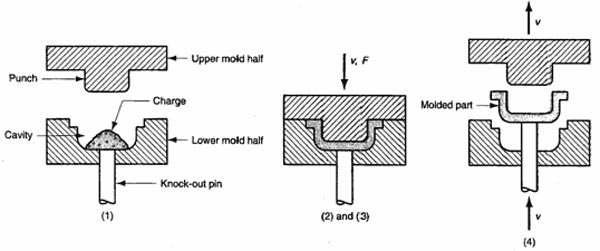If you are looking for one of the most versatile and flexible industrial procedures, then look no further; compression molding provides you with the perfect solution used by both large and small-scale manufacturers.
The manufacturing technique is used to create a wide range of products spanning from gigantic airplane parts to small items such a baby toys and accessories. For this post, we are going to look at everything you need to know about compression molding, its process, applications, and benefits. Without further ado, let’s get into it!
Definition of compression molding
It’s a manufacturing process that entails the pre-heating of molding materials which are in turn compressed forming the desired shape and sizes using dual heating molds.

Compression moulding proces
How does the process work?
The step-by-step process of the overall compression molding process involves:
Creation of molds- Tooling can be created in a wide range of ways such as 3D printing, die casting, and machining just to mention a few
Setting up the machines- Depending on the machine or the device that you are using such as increasing the heat, cleaning of the mold, and other setting-up procedures
Preparation of charge- Choosing the type of material used will be a key determinant of the amount of material. If the charge used is quite big, excess materials will seep from the mold resulting in a flash which will need to be cut manually
Inserting of the charge- Placing of the charge at the center on the base of the mold
Compress part- Close the top of the mold and begin applying pressure and wait for the part of the piece to form. A lot of manufacturers opt to use heat during the overall compression process which not only softens the raw-materials but also increases the production rate.
Releasing of the part- The final process entails the removal of the finished piece
Compression molding Vs Injection molding
In today’s manufacturing world, injection molding and compression molding are quite similar. But they have one key difference; in injection molding, a charge is inserted onto the close mold of the cavity while in compression molding all of the molds are closed around the charge.
Manufacturers use both injection molding and compression molding to create different parts, products, and prototypes. If you intend on creating easy and simple designs then compression molding is better suited to your needs while injection molding is used to create complex and intricate design parts.
The tooling costs of compression molding are much lower compared to injection molding and it also results in minimal wastage of materials making the whole process profitable and cost-effective.
Applications of compression molding
Compression molding is used in a wide variety of applications. Some of the commonly used applications include:
- Automotive parts
- Gaming and computer devices
- Kitchenware
- Electrical components
- Dental and medical devices
Compression molding is a relatively easy tooling procedure that will curate parts and components in a fast and effective manner, For those looking at improving their economies of scale then compression molding is the perfect solution.
